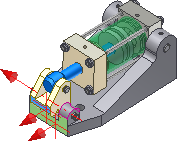
Use the Constrain command or Assemble command to place an Angle constraint between two assembly components. An Angle constraint controls the angle between edges or planar faces.
To begin, place the components to constrain in an assembly file.
Use Constrain to place Angle constraints
|
|
|
|
|
|
Use Assemble to place Directed Angle constraints
-
 On the ribbon, click
Assemble tab
On the ribbon, click
Assemble tab
 Relationships panel
Relationships panel
 Assemble
.
Assemble
. - Select a face or an edge on the component that changes position.
- Select a face or an edge on the component that remains in position.
- Select Angle-Directed from the Solution Type list.
- Enter an angle value, if applicable.
- Do one of the following:
- Click Apply and continue to define constraints.
- Click OK to create the constraints and exit the Assemble command.
- Click Undo to delete the selections and continue to define constraints.
Note: If other components obscure selection, do one of the following:
- Temporarily turn off visibility before you place a constraint. Click to select a component, right-click, and then select Visibility.
- To restrict selectable geometry to a specific part, select Pick Part First in the dialog box, and then click the component you want to constrain. Clear the check box to restore selection mode.